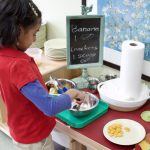In a world filled with constant stimulation, bright colors, and endless choices, it can be easy to assume that more is better, especially when it comes to children. More toys, more books, more learning tools. But in Montessori education, the opposite holds true. At the heart of the Montessori philosophy is the belief that simplicity and intentionality create the ideal conditions for a child’s growth. A carefully prepared, minimalist environment is not just a design choice, it’s a foundational aspect of how children learn, focus, and thrive.
The Montessori classroom is striking in its calm, uncluttered feel. Everything has a place and a purpose. Rather than rows of desks or bins overflowing with toys, you’ll find low shelves with just a few neatly displayed materials. Each item is thoughtfully chosen, not only for its educational value, but for its beauty and clarity of purpose. Natural light, neutral tones, and a sense of order create a peaceful atmosphere where children can settle in, concentrate, and engage deeply.
This approach is grounded in Dr. Maria Montessori’s observation that children flourish when their environment is tailored to their developmental needs. She believed that freedom and independence could only truly emerge within a space that invites focus and self-direction. A minimalist environment helps eliminate distractions and supports a child’s ability to choose work that interests them and to follow through with concentration and care.
Minimalism in the Montessori setting doesn’t mean emptiness or sterility. On the contrary, these environments are full of life. What makes them feel different is that they are intentional. When children enter a space that is not overstimulating, they feel calm, in control, and capable. They are not overwhelmed by options; instead, they are offered meaningful work that encourages independence, problem-solving, and creativity.
This philosophy doesn’t end at the classroom door. Parents can bring the same principles into their home in simple, impactful ways. Creating a small, accessible shelf with just a few toys or books at a time helps children focus and appreciate what they have. Rotating materials keeps things fresh without adding clutter. Involving children in tidying up or preparing their space fosters responsibility and a sense of ownership. Even the way we decorate, a focus on natural textures, soft lighting, and clear spaces, can support the same peaceful tone that Montessori environments are known for.
At its core, the Montessori method invites us to reimagine what children really need. It teaches us that when we remove the unnecessary, we make space for meaningful experiences. By offering less, we actually give our children more, more clarity, more confidence, and more freedom to grow.
At Casa dei Bambini Montessori Aurora, we see this every day. Our classrooms are designed to reflect the values of simplicity and purpose, creating an atmosphere where children feel both calm and inspired. If you’re curious about what a prepared Montessori environment looks like and how it can benefit your child, we’d love to show you.







